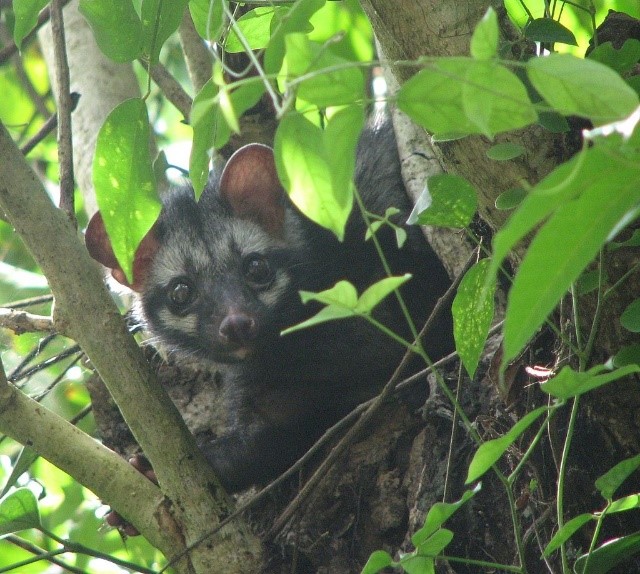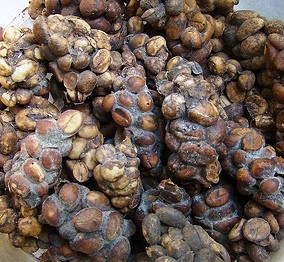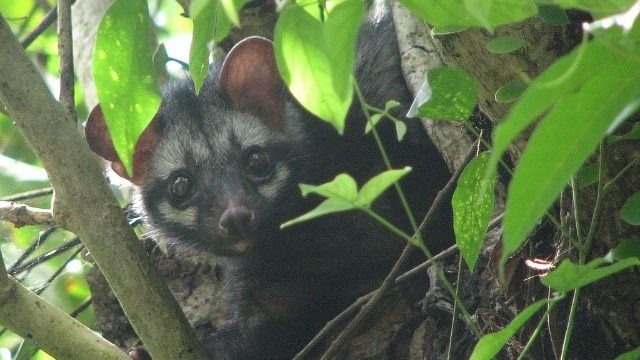BY: ALEX PIERCE-FELDMEYER
Kopi is the word for coffee in the Bahasa Indonesian language. Luwak is an Indonesian name of the Asian palm civet native to Southeast Asia shown in the picture below.1 The Asian palm civet (Paradoxurus hermaphroditus) is from the Viverridae family. For more on this family of mammels click here. Some call it a cat. However it is not a cat.
Coffee from a civet? What?!
Kopi Luwak is Indonesian coffee that is made from partially digested coffee beans eaten and defecated by a civet. Yep, you heard that right. Farmers specifically seek out civet droppings, and collect the feces with the coffee beans for further cleaning and processing. Want to know the craziest aspect about these coffee beans??! These beans go for hundreds of dollars per pound!2
The steep cost is a direct result from the drawn-out process of the cultivation of Kopi Luwak beans, unlike other coffee beans. This bean is defined by its processing. First a civet will actually cherry pick the beans and once consumed, the beans pass through the intestines and ferment. Due to the presence of digestive enzymes in the civet digestive tract, proteins inherent to the bean are broken down. These processes are believed to add to the overall flavor profile6 and are therefore necessary for the production of authentic Kopi Luwak, giving these coffee beans quite a unique story.2
So how did this seemingly disgusting idea turn lucrative?
During the 1800’s Dutch East Indies colonies of Java and Sumatra produced coffee from plantations of Arabica Coffee. The Dutch forbid the native workers from picking fruits off the coffee tree for themselves, but were able to collect coffee beans that fell off the tree. It was not long after that the natives learned civets consumed the fruits and left the undigested seeds in their feces. They were collected, cleaned, roasted and ground for their own use, and this practice eventually spread throughout the colonies. Because it was time-consuming to produce these coffee beans by hunting wild civet droppings, it became a very expensive commodity. Sources claim it wasn’t until tourism became popular in Bali that this ‘delicacy’ developed more interest and demand.3

source: http://intimate-indonesia.blogspot.com/2012/03/kopi-luwak-most-expensive-coffee-of.html?_sm_au_=iVV21FRQZnZwtSJr
It’s about the journey
These beans fetch such high prices because the traditional ways of producing this coffee takes so much energy and time. Farmers search through forests and land where five to six beans may be collected per dropping. Farmers say the best time to find the droppings is early morning due to the civet’s nocturnal lifestyle. But you can imagine how long it takes to collect enough beans for pounds of production since there is no automated, high-efficiency method for the bean collection or cleaning.3The cleaning process is very demanding, as one might imagine – food borne illness often originates from fecal contamination. This might be the most fecally contaminated food product I can come up with…
Kopi Luwak farmers from a plantation in Indonesia describe their cleaning process:
“After collection, we wash the beans to remove the outer shell and then dry them in the Indonesian sun. After drying, we wash a second time to ensure all outer shells are removed. At this point we re-dry the beans again. Finally, right before we are ready to ship to you, we roast the beans at 220 degrees Celsius. At this temperature, no bacteria can survive.”4
Where there’s money, there’s a will to produce
Expectedly, the bean price has led to nontraditional producers attempting to find a more efficient way to make more Kopi Luwak, which has caused some controversy.
There has been reported animal cruelty associated with people using cages to contain civets and feeding them coffee beans in 2012 and 2013.5-6 These practices were brought to the attention of the government in order to crack down on those using cruel measures to produce the coffee. Eventually, the negative attention drew many to support the ban of the ‘industrialized’ version of Kopi Luwak production. This was also a popular view due to the support it was taking away from the traditional farmers that rely on Kopi Luwak production for living wages.3
However, the civet induced coffee bean transformation began to gather prestige instead of disgust. The beans became more popular in the mid 1990’s and producers capitalized on this by putting civets on the package. One hundred grams of Luwak beans were selling for between $40-$80. Other ‘dropping’ coffee beans have been produced in a similar manner, but have not gathered quite the esteem as traditional wild Kopi Luwak.

source: https://www.amazon.com/Caf%C3%A9s-Granell-Luwak-Coffee-100grams/dp/B01HS3IZIU
Though, the industrialized Kopi Luwak production also received backlash for its perceived lower quality. Traditionalists claim the civets’ choice of the beans may affect the overall coffee profile and that the choice beans coupled with processing through the digestive tract of the civet make the coffee unique and are the reasons for its unique flavor profile.2
This coffee’s sensory profiles have become so premium that many still try to take short cuts and market fraudulent beans as Kopi Luwak. In order to detect differences scientists have developed ways to analyze the beans to preserve their integrity. These methods include metabolomics and gas chromatography. Metabolomics is about studying products formed from specific biological cellular processes, providing a “snapshot” of an organism’s physiology.8Jumhawan et al. (2013) used metabolite profiling to discover different metabolic markers between regular and civet coffee. They also focus on ways to make regulation less expensive and more efficient.9
Ensuring “quality” of Kopi Luwak meant ensuring the beans came from wild civets. A London specialty coffee buyer even worked with British organizations to help develop a certification standard for Kopi Luwak, ensuring that the beans were from wild civets and not caged ones.3
Kopi Luwak flavor profile?
Historically the bean was used because many believed it carried a more flavorful profile than coffee from the regular beans of cherries that had fallen to the ground.3 Sources have described the profile of Kopi Luwak to be ‘smooth, chocolatey and devoid of bitter aftertaste,”2 and “earthy, musty, syrupy, smooth, and rich with both jungle and chocolate undertones.”7
Other roasters agree on enhanced smoothness and that the floral and fruity notes stem from fermentation enzyme breakdown processes as the beans travel through the civet.7 It is believed that digestive enzymes break down the protein molecules that usually would give a cup of coffee its bitterness.3
Marcone (2004) has analyzed the coffee beans. Using analytical methods such as Scanning electron microscopy (SEM), researchers were able to form a highly detailed image of the coffee bean surface.
Scanning Electron Microscopy: the surface of the coffee bean in this case, was scanned with a beam of electrons that interacts with the atoms to form a highly detailed image reflecting the beans topography

The surface of a Kopi Luwak coffee bean before process through wild civet.7 The image was produced with SEM.

The surface of a Kopi Luwak coffee bean after process through wild civet. 7 The image was produced with SEM.
The study found the beans to possess pitted surface caused by the gastric juices and enzymes of the civets’ digestive tracts. Other methods like gel-electrophoresis in which charged molecules are separated based on their mass were used to identify and isolate proteins—showing that enzymes were penetrating the civet beans. This is important because this penetration and change in structure is what causes the breakdown of proteins, leading to differences in Maillard browning flavor products, ultimately affecting the flavor profiles. This supports the belief of the civet’s digestive process giving this coffee its distinct flavor.7
Opinions on this coffee
It sounds like this coffee might just be delicious. But it seems that opinions are split. Business Insights Global claimed it was “fully worth both the praise and the price.3” The specialty coffee enthusiasts, however, may disagree. Sam Ryo, Co-founder and Head Brewer for Lokal Cold Brew shared his opinion with me about the specialty coffee community’s views on Kopi Luwak. He discussed how Hollywood popularized this bean, but that many within the specialty coffee community describe Kopi Luwak as inferior tasting coffee, that it is thin and lacks acidity, as well as other traits that are found in specialty coffee. Sam is quick to understand why the profile might get a following because many average coffee drinkers ‘shy away from bright, acidic’ profiles, Sam said. Specialty Coffee tasters believe the Kopi Luwak has a phenolic off note (clove like). Sam describes this off note as more ‘band-aid like.’
Speciality coffee enthusiasts do have a coffee they think is worth the price: Gesha varieties, so called for its origin being Gesha Village in Ethiopia.10 The bean undergoes a unique fermentation style delivering the complexity of this cup, described as aromatic, fruity and floral.11 The flavor varies, Sam explains, but says varieties may express notes of lemongrass, bergamot and jasmine. This coffee costs no less than $136/pound.11 Some of this coffee was secured by Boston’s George Howell Coffee, and according to specialty coffee connoisseurs, is worth the trip!
In fact, many have become quite passionate about the demotion of Kopi Luwak:
“So have you heard of that umm…cat poop coffee?”12
Kopi Luwak’s fame is more about the novelty of the bean and less about the flavor. Kopi Luwak’s story and process make it premium, but its sensory properties are debatable. Perhaps you will have to try a cup of Kopi yourself to determine if you believe the hype! 13 It’s easy to find some beans online, but it might be harder to ensure they are from wild civets. For an extra challenge, try hunting for the beans yourself!
Just remember to clean them.
Enjoyed the article? Come check out our Instagram and Facebook for more weekly blog updates, news, and food science!
REFERENCES
-
http://cluwak.com/kopi-luwak-cluwak-aboutus)
-
https://www.nytimes.com/2010/04/18/world/asia/18civetcoffee.html?pagewanted=all
-
Wallengren, Maja. “Sacred beans: hunting for Kopi Luwak coffee.” Tea & coffee Trade Journal 2016: 46+. Business Insights: Global. Web. 14 Aug. 2018
-
https://www.kayakopi.com/cleaning-process/
-
https://www.theguardian.com/environment/2012/nov/19/civet-coffee-abuse-campaigners?_sm_au_=iVV5FsFSDrQqVS1Q
-
https://www.bbc.co.uk/news/uk-england-london-24034029?_sm_au_=iVV5FsFSDrQqVS1Q
-
Marcone, M. F. (2004). Composition and properties of Indonesian palm civet coffee (Kopi Luwak) and Ethiopian civet coffee. Food Research International, 37(9), 901–912. https://doi.org/10.1016/j.foodres.2004.05.008
-
https://en.wikipedia.org/wiki/Metabolomics
-
Jumhawan, Udi, et al. “Selection of discriminant markers for authentication of asian palm civet coffee (kopi luwak): a metabolomics approach.” Journal of agricultural and food chemistry33 (2013): 7994-8001.
-
https://en.wikipedia.org/wiki/Geisha_(coffee)
-
https://dailycoffeenews.com/2017/10/26/ninety-plus-panama-coffee-earns-2273-per-pound-described-as-evoking-erotic-innervation/https://sprudge.com/say-no-to-kopi-luwak-15101.html
-
https://sprudge.com/say-no-to-kopi-luwak-15101.html
-
https://www.amazon.ca/s/?ie=UTF8&keywords=kopi+luwak+coffee&tag=googcana-20&index=aps&hvadid=208376727823&hvpos=1t1&hvnetw=g&hvrand=11667083022367258278&hvpone=&hvptwo=&hvqmt=b&hvdev=c&hvdvcmdl=&hvlocint=&hvlocphy=9000806&hvtargid=kwd-296173281080&ref=pd_sl_295d9kgy6f_b






link alternatif sbobet asd
sabung ayam bangkok wah